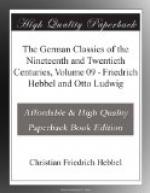When the poet attempts to delineate characters by making them speak, he must be careful not to allow them to speak about their own inner life. All their utterances must relate to something external; only then does their inner nature come out vividly and expressively, for it fashions itself only in reflections of the world and of life.
To depict two kindred characters one by means of the other, to have them mutually reflect one another without their becoming aware of it, would surely be the triumph of delineation.
It is a masterly trait in the Prince of Homburg that the suspicion that the Elector has had the Prince condemned to death, not so much on account of the act of overhastiness committed on the battlefield as for another reason, does not arise spontaneously in the Prince’s soul, but is first awakened by Hohenzollern’s questioning.
A double process must take place in the mind of the true poet before it can evolve anything. The crude matter must be resolved into an idea, and the idea must condense again into a form. Man is the continuation of the act of creation, an eternally growing, never completed creation, which prevents the termination of the world and keeps it from congealing and hardening. It is highly significant (this thought led me to the one I have just expressed) that everything which exists as a human conception is never wholly and perfectly—only fragmentarily—embodied in nature, and everything which exists perfectly and completely in nature eludes human conception, man’s own nature not excepted. Thus we know and define right and wrong, virtue and innocence (the latter as soon as we have lost it), but not life itself, etc. Where knowledge has been vouchsafed us, there nature requires our cooeperation.
The first and last aim of art is to render intuitively perceptible the process of life itself, to show how the soul of man develops in the atmosphere surrounding him, let it be suited to him or not, how good engenders evil within him, and evil in turn produces something less evil, and how this eternal growth has a limit so far as our apprehension is concerned, but none at all in reality; this is symbolization. It is an error when men say that only the fully developed is matter for the poet; on the contrary, what is in process of development, what is first begotten in conflict with the elements of creation, that is matter for him. What is finished can be only a plaything of the waves, it can only be destroyed and devoured by them; can art have anything to do with that which is most common, in other words, most universal? But what is in process of development must pass from one form into another at the hands of the poet, it must never as formless soft clay dissolve before our eyes into chaos and confusion; it must always, in a certain sense, be at the same time a finished product, just as in the universe we never encounter naked raw material. Man exists only because of his future;




